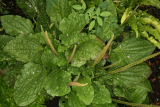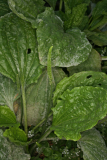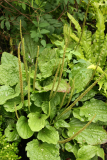Additional notes (click to expand)
Medicinal
Culpeper: ‘Plantago. Plantane... an herb though common, let none despise it, for the decoction of it prevails mightily against tormenting pains and excoriations of the guts, bloody fluxes, it stops the terms and spitting of blood, Phtisicks or consumption of the lungs, the running of the reins and the whites in women, pains in the head and frenzies: outwardly it clears the sight, takes away inflammations, scabs, itch, the shingles, and all spreading sores, and is as wholesome a herb as can grow about a house.
Culpeper, Nicholas. (1650). A Physical Directory . London, Peter Cole.
Medicinal uses
Uses supported by clinical data
No information was found.
Uses described in pharmacopoeias and well established documents
Plantago major is used internally for catarrh of the respiratory tract,
cough, bronchitis, infl ammatory alterations of the oral mucosa, phlegm
congestion, nephritis, cystitis, urinary retention, dysentery, epistaxis
(nosebleed) and excessive diaphoresis (49, 50). It is also used for the treatment
of diarrhoea and constipation (22).
Uses described in traditional medicine
Fresh leaves of Plantago major have been used externally for centuries in
many parts of the world as an antiseptic for treatment of skin irritations,
erysipelas, abscesses, burns, scrofula and infl ammatory reactions of the skin; for repair of damaged tissue; and to treat fi stulae and ulcers (5, 43,
51, 52). It is also used to suppress cough associated with bronchitis, colds
and upper respiratory infl ammation, and as an analgesic and diuretic
agent, in the treatment of kidney stones (53–55). It also has a hepatoprotective
action (4, 56). Plantago major leaves have been used as a weak antibiotic,
astringent (57) and as an immunomodulating (58), antihypertensive
(59), hypoglycaemic (60), haemostatic (61), antiallergic, febrifuge and
antipruritic agent (62). It is used in the treatment of eye infl ammation, and
as a vermifuge (63–65). It is commonly prescribed for treatment of cystitis
with haematuria and haemorrhoids (38).
Contraindications
In case of hypersensitivity to P. major pollen (e.g. contact dermatitis), use
should be stopped.
WHO monographs on medicinal plants commonly used in the Newly Independent States (NIS). 2010. WHO, Geneva
Nomenclature
OTHER COMMON NAMES: GREATER PLANTAIN; COMMON PLANTAIN; CART TRACK PLANT; HEALING BLADE; LAMB'S FOOT; LARK SEED; WHITE MAN'S FOOT; WHITE MAN'S FOOTPRINT
The Royal Horticultural Society Horticultural Database, available at www.rhs.org.uk
Other use
Notes: This is best known to gardeners as the plant that grows happily in one’s lawn. In Pompei it is still used to treat colitis. Dioscorides called it Arnoglossum, and lists all sorts of diseases that it treats, from dropsy to erysipelas.
Oakeley, Dr. H. F. . (2013). The Gardens of the Pharmacopoeia Londinensis.
link
Used by the Caribs for eye inflammation, and 'the leaves have also been used as a tea in awssociation with mint thyme and salt to counteract shock. 'In Africa the leaf juice was used for Malaria'. Used in Martinique as a hot tea to bring on menstruation, and for wind or stomach pain.
Honeychurch, P.N. . (1980). Caribbean Wild Plants and their Uses - An illustrated guide to some medicinal and Wild ornamental plants of the West Indies. Self published. page 60
Geographical distribution
- Asia-Temperate
- Europe
Podcast
Plantago major L.
Family: PLANTAGINACEAEGenus: Plantago
Species: major L.
Common names: Greater Plantain
Pharmacopoeia Londinensis name: Plantago
Distribution summary: Eurasia
Habit: Perennial
Hardiness: H5 - Hardy; cold winter
Habitat: Stream banks, scrub and waste or disturbed ground
Garden status: Currently grown
Garden location: Pharmacopoeia Londinensis 1618 'Leaves' (HSE 6)
Reason for growing: Medicinal
.JPG)


.JPG)


.JPG)